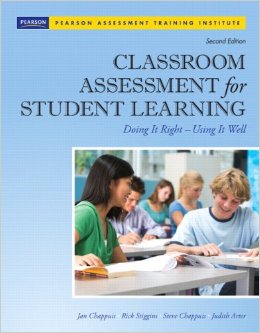Classroom Assessment Chapter 4

To help us work towards our school goal of improving our understanding and practice of assessment, my principal has provided our staff with a copy of Classroom Assessment for Student Learning: Doing it Right – Using it Well, by Jan Chappuis, Rick Stiggins, Steve Chappuis, and Judith Arter. As I make my way through the book, I will be summarizing my learning as a means of organizing my thoughts and getting clarification on particular ideas.
 |
| Classroom Assessment for Student Learning Cover. (Accessed 2016). Uploaded to Amazon; Pearson Education. Available online at: https://www.amazon.ca/Classroom-Assessment-Student-Learning-Doing/dp/0132685884 |
Chapter 4 – Sound Design
*teachers vary assessment methods to offer choice and/or accommodate learning preferences but methods should match the learning targets
Assessment Options
1 ) Selected Response
– chose the correct response from a previous list
– multiple choice, true & false, matching, fill-in-the-blanks
– judged correct or incorrect
2 ) Written Response
– construct a response based from a prompt
– short answer, extended response
– judged by a scoring criteria/rubric
3 ) Performance Response
– observation of real-time demonstration or products
– playing an instrument, lab reports, wood shop creations
– judged by a scoring criteria/rubric
4 ) Personal Communication
– structured or unstructured interactions
– participation, student journals, interviews/conferences
– good for determining misunderstandings and giving immediate feedback
*You can determine what type of assessment method matches particular types of learning targets by using this table
 |
| Chappius, et al. (2012). Figure 4.3 Target Method Match. Classroom Assessment for Student Learning, pg 94. |
Assessment Development Cycle
1 ) Determining Users & Uses
– who will use the results?
– how will they use the results?
– is it formative or summative? (if formative, remember the 4 steps from Ch. 1)
2 ) Specify the Intended Learning Targets
– determine if its knowledge, reasoning skill or product (see Ch. 3)
3 ) Select the Appropriate Assessment Match
– see image above
4 ) Determine an Appropriate Sample Size
– “how much evidence is enough?” “how long should the assessment be?”
a ) assessment purpose
– an exit slip to guide tomorrow’s lesson requires less evidence than a final exam
b ) nature of the learning target
– the broader the target, the more complex and the more evidence that is needed
– procedural knowledge is short, competent writing is complex
c ) assessment method
– you may need more multiple choice questions because they only ask limited information at a time
– written response questions can cover more so you need less of them
d ) the students
– use professional judgement; you know when students “get it” and which ones need more evidence
– this is more relevant during formative than summative
Assessment Blueprints
– helps ensure the assessment is measuring what you need it to: validity
– example table
|
Learning
Target
|
Target
Type
|
Assessment Option
|
Total
%
|
|
|
|
|
|
*try to account for potential sources of bias or distortion; good planning helps but you’ll never be able to address all of them with all students
 |
| Chappius, et al. (2012). Figure 4.7 Potential Sources of Bias and Distortion Common to All Assessment Methods. Classroom Assessment for Student Learning, pg 112. |
_____________________________________________
I WANT TO KNOW:
What exactly differentiates between an extended writing assessment and a performance task?
Lab reports are under performance… not writing. The chapter also includes term papers as performance tasks where I would have thought of them as writing tasks.
Please leave your thoughts below 🙂